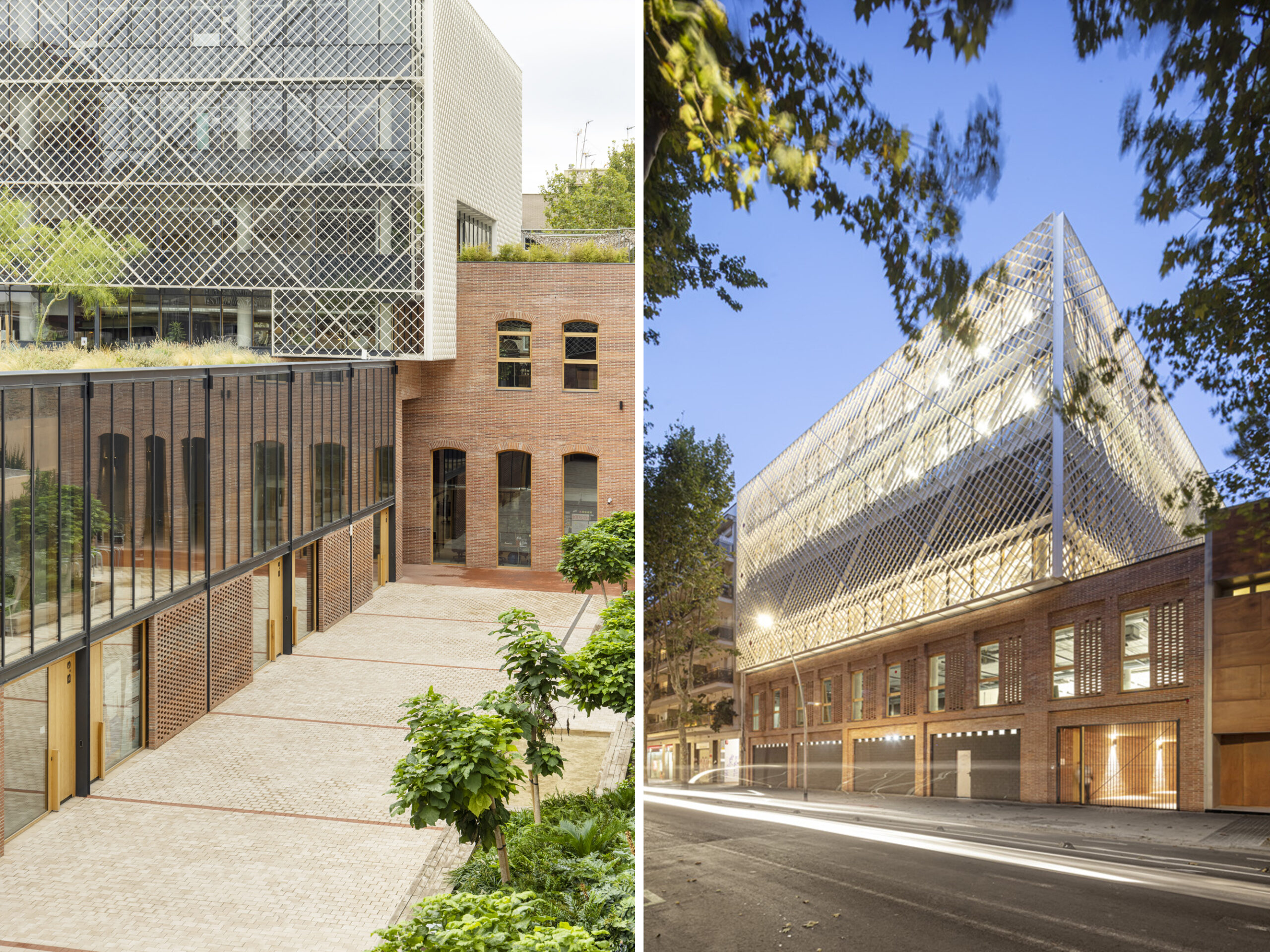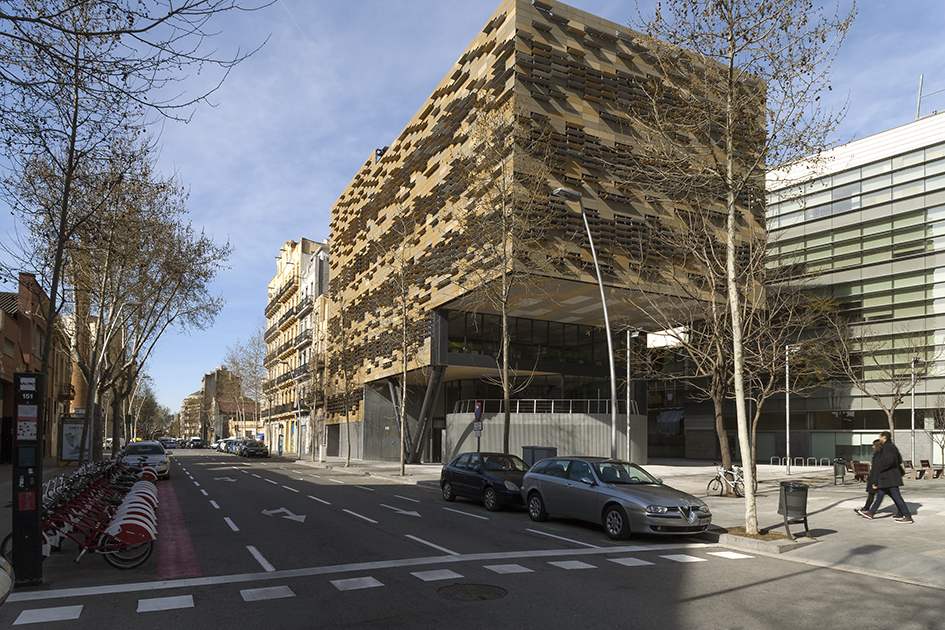Architizer’s 13th A+Awards features a suite of sustainability-focused categories recognizing designers that are building a greener industry — and a better future. Start your entry to receive global recognition for your work!
The transformation of the 22@ district from a neglected industrial area into a thriving innovation hub has significantly impacted Barcelona’s economy, culture and urban environment. As an innovation district — an urban area where businesses, research centers and startups coexist to promote collaboration and technological development — 22@ is a thriving area that emerged from a revitalization process.
One of its greatest achievements is its ability to juxtapose preservation and innovation. The district embraces modern development, while it honors its industrial past with repurposed industrial buildings and preserved smokestacks integrated into contemporary architecture. This balanced symbiosis of heritage and progress has given the neighborhood a distinct identity, attracting international companies and creative startups. Companies like Amazon, Meta and Microsoft have established a presence in the area, fueling job creation and drawing global talent.
Additionally, Barcelona’s geographical location on the Mediterranean coast, its pleasant year-round climate and its high quality of life have undoubtedly contributed to the success of the 22@ innovation district.
From Catalan Manchester to 22@
Xavier Badia Castellà, Roc Boronat 45-53, CC BY-SA 3.0
Poblenou’s industrial activity was at its height in the late 19th and early 20th century. This Barcelona neighborhood became known as the “Catalan Manchester.” In the 1960s, the area’s industrial activity started shift to other locations outside the city. Most of the remaining industrial structures were abandoned and others were used temporarily as storage facilities, workshops and artist studios.
The transformation of the Poblenou neighborhood began with the 1992 Olympics, which brought significant urban improvements, including revitalizing the waterfront. These substantial changes laid the groundwork for further redevelopment.
In 2000, the City Council launched an initiative to regenerate 200 hectares of Poblenou’s underutilized land. Over the past two decades, the former industrial neighborhood has become a vibrant mixed-use district known as 22@, where cultural, scientific and technological activities coexist alongside housing, restaurants, hotels and parks. While the neighborhood has embraced modern development, its industrial heritage remains visible in the preserved structures, repurposed for new business uses and thoughtfully integrated into the contemporary urban fabric.
A good example of adaptive reuse is the KNEM project, whose design reimagines an existing jute spinning mill into a new facility to accommodate new office space. The design preserves the original main façade under the Architectural Heritage Protection Plan, juxtaposed with new glass boxes screened behind aluminum screens, evoking the weaving of jute fibers. KNEM Offices is one of many similar projects that breathe new life into the former industrial neighborhood, merging its history with innovative functionality.
Smokestacks as Landmarks of Urban Transformation

Industrial Smokestack preserved in Campus de la Comunicació, Universitat Pompeu Fabra, Poblenou (Barcelona) | Photo by Teresa Grau Ros via Flickr CC BY-SA 2.0
22@ takes its name from the original “22a” industrial zoning denomination, which identified manufacturing areas. This denomination was reinterpreted as 22@ to be more in tune with the new development plan with innovative and technological aspirations. The former industrial neighborhood has been transformed into a modern hub for education, research, and business, but its industrial heritage remains.
Perhaps the most symbolic feature of this revitalization is the preservation of the industrial smokestacks and their integration into new developments. Once essential for the textile and manufacturing industries in the Poblenou neighborhood, these towering smokestacks were prominent features of Barcelona’s skyline. No longer functional, many have been preserved as monuments. As the neighborhood’s redevelopment evolves toward a modern and dynamic hub for innovation and technology, the smokestacks are visual anchors to the neighborhood’s former industrial activity.
Today, the iconic brick smokestacks stand among cutting-edge buildings linking Poblenou’s industrial past and its new identity as an innovation district. Some developments go beyond the mere preservation efforts, integrating the smokestacks into new buildings and open public spaces to emphasize their relevance in the history and culture of Barcelona and the Catalan region.
Innovation, Connectivity, and Urban Life

KNEM Offices by b720 Fermín Vázquez Arquitectos, Barcelona, Spain | Photo by Oriol Gómez
The brick towers have served as landmarks that unify the entire 22@ innovation district. Whether they are a distinctive feature of a new building or a monument in a public open space, they knit together a new urban fabric. The neighborhood’s transformation promotes innovation and progress, emphasizing a compact development approach that optimizes land use while fostering a mixed-use environment. Residential, commercial, cultural, educational, hospitality and office buildings form an urban setting that supports work and daily life. Furthermore, 22@ reflects pedestrian-friendly urban design, prioritizing public transportation, bicycle lanes and open areas.
This emphasis on connectivity goes beyond buildings. Many architectural projects are sometimes tied to communal open spaces, creating a cohesive new urban fabric. Unlike isolated business campuses that are only accessible by car and with little emphasis on quality of life, 22@ supports an environment that integrates work, housing and recreation, reinforcing a sense of community and accessibility.
An Experimental Laboratory for the City’s Evolving Identity

Technology Center Leitat by Picharchitects/Pich-Aguilera. Barcelona, Spain | Photo by Lourdes Jansana
The Torre Glòries by Jean Nouvel symbolizes the transformation of the former industrial area into a new innovation district. Also, the Media-TIC building by Enric Ruiz Geli is an experimental architectural landmark embodying principles of innovation and sustainability. Beyond these iconic structures, many remodeled industrial buildings and new constructions balance heritage and innovative design. This combination creates a vibrant mixed-use hub where universities, start-ups, business incubators and accelerators, residential buildings, restaurants, hotels and parks coexist.
The area is an experimental laboratory for innovative architecture and urban planning, much like Idelfons Cerdà’s Eixample grid for efficient city expansion in the 19th century. The 1992 Olympics also transformed neglected areas into thriving developments and revitalized the city’s coastline — a lasting urban planning legacy. 22@ follows in these footsteps by introducing adaptive reuse strategies, implementing sustainable principles and creating innovative open spaces woven into a cohesive urban fabric.
Much like the towering brick smokestacks, the neighborhood’s modern highrises redefine the city’s skyline, signaling a new era of progress, juxtaposing history and progress while shaping the city’s evolving identity.
Preserving the Past, Building the Present
The transition from an industrial district to a mixed-use neighborhood highlights Barcelona’s ability to blend history with progress. By revitalizing a former industrial area — adapting its abandoned structures to accommodate a mix of uses — and building new cutting-edge constructions, the district thrives as a dynamic hub for economic development and urban regeneration.
However, this transformation was not without challenges. Significant changes to zoning laws were required to allow for a new urban framework, integrating residential, commercial and technological development. It also needed substantial infrastructure improvements that involved the upgrade of existing infrastructure to support the growing residential and business populations. Another challenge involved enhancing the public transportation system to ensure the area is well-connected to the rest of the city.
Sustainability has been central to this transformation process, emphasizing compact development and prioritizing a pedestrian-friendly environment with access to public transportation and public spaces. These initiatives have reinforced Barcelona’s leading role as a pioneer in urban planning. The 22@ is a testament to the city’s forward-thinking approach, prioritizing evolution while honoring its historic legacy. It highlights a vision where the past fuels the future, shaping a unique urban landscape. Brick smokestacks, once vital to the industrial heart of the Poblenou, now stand alongside cutting-edge buildings, transforming the neighborhood’s skyline and reinforcing the city’s evolving identity.
Architizer’s 13th A+Awards features a suite of sustainability-focused categories recognizing designers that are building a greener industry — and a better future. Start your entry to receive global recognition for your work!

